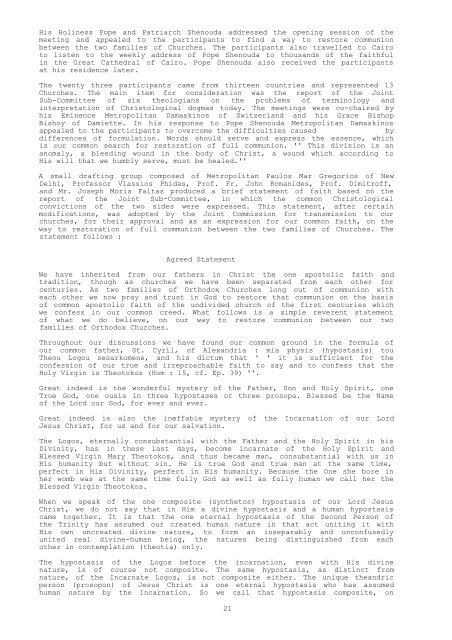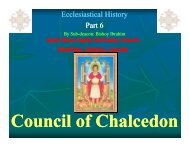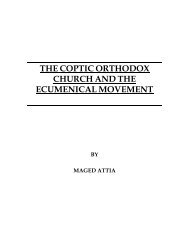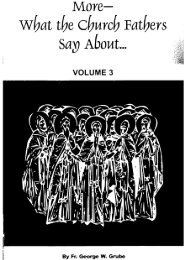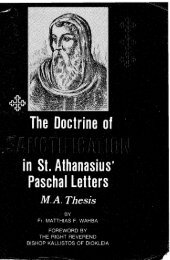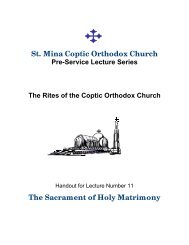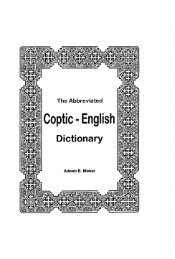Coptic interpretations of the Fourth Ecumenical Council - Saint Mina ...
Coptic interpretations of the Fourth Ecumenical Council - Saint Mina ...
Coptic interpretations of the Fourth Ecumenical Council - Saint Mina ...
You also want an ePaper? Increase the reach of your titles
YUMPU automatically turns print PDFs into web optimized ePapers that Google loves.
His Holiness Pope and Patriarch Shenouda addressed <strong>the</strong> opening session <strong>of</strong> <strong>the</strong><br />
meeting and appealed to <strong>the</strong> participants to find a way to restore communion<br />
between <strong>the</strong> two families <strong>of</strong> Churches. The participants also travelled to Cairo<br />
to listen to <strong>the</strong> weekly address <strong>of</strong> Pope Shenouda to thousands <strong>of</strong> <strong>the</strong> faithful<br />
in <strong>the</strong> Great Ca<strong>the</strong>dral <strong>of</strong> Cairo. Pope Shenouda also received <strong>the</strong> participants<br />
at his residence later.<br />
The twenty three participants came from thirteen countries and represented 13<br />
Churches. The main item for consideration was <strong>the</strong> report <strong>of</strong> <strong>the</strong> Joint<br />
Sub-Committee <strong>of</strong> six <strong>the</strong>ologians on <strong>the</strong> problems <strong>of</strong> terminology and<br />
interpretation <strong>of</strong> Christological dogmas today. The meetings were co-chaired by<br />
his Eminence Metropolitan Damaskinos <strong>of</strong> Switzerland and his Grace Bishop<br />
Bishoy <strong>of</strong> Damiette. In his response to Pope Shenouda Metropolitan Damaskinos<br />
appealed to <strong>the</strong> participants to overcome <strong>the</strong> difficulties caused by<br />
differences <strong>of</strong> formulation. Words should serve and express <strong>the</strong> essence, which<br />
is our common search for restoration <strong>of</strong> full communion. '' This division is an<br />
anomaly, a bleeding wound in <strong>the</strong> body <strong>of</strong> Christ, a wound which according to<br />
His will that we humbly serve, must be healed.''<br />
A small drafting group composed <strong>of</strong> Metropolitan Paulos Mar Gregorios <strong>of</strong> New<br />
Delhi, Pr<strong>of</strong>essor Vlassios Phidas, Pr<strong>of</strong>. Fr. John Romanides, Pr<strong>of</strong>. Dimitr<strong>of</strong>f,<br />
and Mr. Joseph Moris Faltas produced a brief statement <strong>of</strong> faith based on <strong>the</strong><br />
report <strong>of</strong> <strong>the</strong> Joint Sub-Committee, in which <strong>the</strong> common Christological<br />
convictions <strong>of</strong> <strong>the</strong> two sides were expressed. This statement, after certain<br />
modifications, was adopted by <strong>the</strong> Joint Commission for transmission to our<br />
churches, for <strong>the</strong>ir approval and as an expression for our common faith, on <strong>the</strong><br />
way to restoration <strong>of</strong> full communion between <strong>the</strong> two families <strong>of</strong> Churches. The<br />
statement follows :<br />
Agreed Statement<br />
We have inherited from our fa<strong>the</strong>rs in Christ <strong>the</strong> one apostolic faith and<br />
tradition, though as churches we have been separated from each o<strong>the</strong>r for<br />
centuries. As two families <strong>of</strong> Orthodox Churches long out <strong>of</strong> communion with<br />
each o<strong>the</strong>r we now pray and trust in God to restore that communion on <strong>the</strong> basis<br />
<strong>of</strong> common apostolic faith <strong>of</strong> <strong>the</strong> undivided church <strong>of</strong> <strong>the</strong> first centuries which<br />
we confess in our common creed. What follows is a simple reverent statement<br />
<strong>of</strong> what we do believe, on our way to restore communion between our two<br />
families <strong>of</strong> Orthodox Churches.<br />
Throughout our discussions we have found our common ground in <strong>the</strong> formula <strong>of</strong><br />
our common fa<strong>the</strong>r, St. Cyril, <strong>of</strong> Alexandria : mia physis (hypostasis) tou<br />
Theou Logou sesarkomene, and his dictum that ' ' it is sufficient for <strong>the</strong><br />
confession <strong>of</strong> our true and irreproachable faith to say and to confess that <strong>the</strong><br />
Holy Virgin is Theotokos (Hom : 15, cf. Ep. 39) ''.<br />
Great indeed is <strong>the</strong> wonderful mystery <strong>of</strong> <strong>the</strong> Fa<strong>the</strong>r, Son and Holy Spirit, one<br />
True God, one ousia in three hypostases or three prosopa. Blessed be <strong>the</strong> Name<br />
<strong>of</strong> <strong>the</strong> Lord our God, for ever and ever.<br />
Great indeed is also <strong>the</strong> ineffable mystery <strong>of</strong> <strong>the</strong> Incarnation <strong>of</strong> our Lord<br />
Jesus Christ, for us and for our salvation.<br />
The Logos, eternally consubstantial with <strong>the</strong> Fa<strong>the</strong>r and <strong>the</strong> Holy Spirit in his<br />
Divinity, has in <strong>the</strong>se last days, become incarnate <strong>of</strong> <strong>the</strong> Holy Spirit and<br />
Blessed Virgin Mary Theotokos, and thus became man, consubstantial with us in<br />
His humanity but without sin. He is true God and true man at <strong>the</strong> same time,<br />
perfect in His Divinity, perfect in His humanity. Because <strong>the</strong> One she bore in<br />
her womb was at <strong>the</strong> same time fully God as well as fully human we call her <strong>the</strong><br />
Blessed Virgin Theotokos.<br />
When we speak <strong>of</strong> <strong>the</strong> one composite (syn<strong>the</strong>tos) hypostasis <strong>of</strong> our Lord Jesus<br />
Christ, we do not say that in Him a divine hypostasis and a human hypostasis<br />
came toge<strong>the</strong>r. It is that <strong>the</strong> one eternal hypostasis <strong>of</strong> <strong>the</strong> Second Person <strong>of</strong><br />
<strong>the</strong> Trinity has assumed our created human nature in that act uniting it with<br />
His own uncreated divine nature, to form an inseparably and unconfusedly<br />
united real divine-human being, <strong>the</strong> natures being distinguished from each<br />
o<strong>the</strong>r in contemplation (<strong>the</strong>otia) only.<br />
The hypostasis <strong>of</strong> <strong>the</strong> Logos before <strong>the</strong> incarnation, even with His divine<br />
nature, is <strong>of</strong> course not composite. The same hypostasis, as distinct from<br />
nature, <strong>of</strong> <strong>the</strong> Incarnate Logos, is not composite ei<strong>the</strong>r. The unique <strong>the</strong>andric<br />
person (prosopon) <strong>of</strong> Jesus Christ is one eternal hypostasis who has assumed<br />
human nature by <strong>the</strong> Incarnation. So we call that hypostasis composite, on<br />
21


